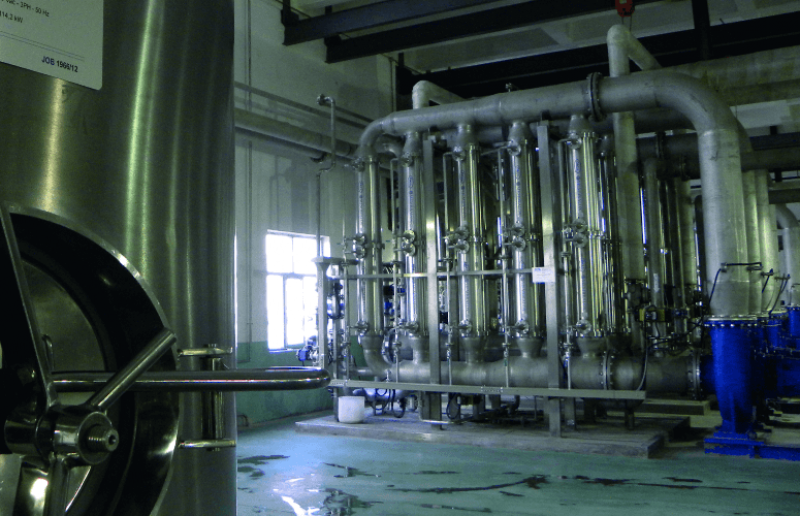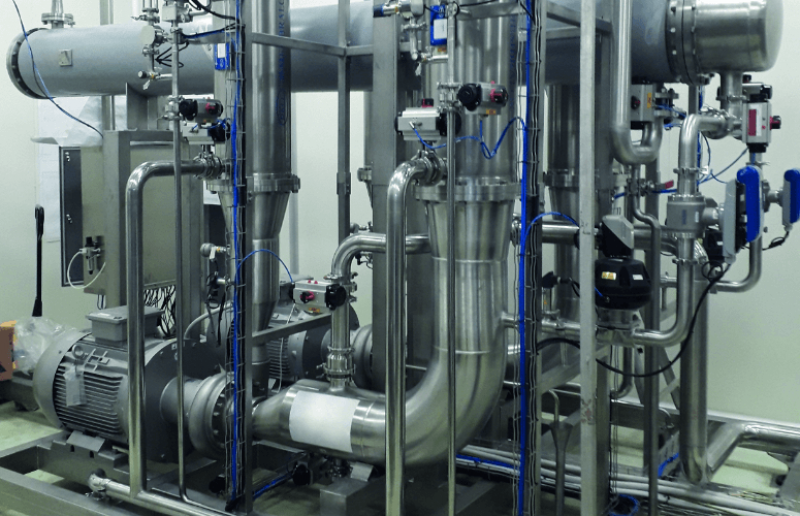Microfiltration & Ultrafiltration
Low pressure process for selective filtration of large molecules

Microfiltration (MF)
Microfiltration (MF) is the bigger pore size cross-flow filtration process. Typical application of this low pressure process is the removal of high molecular weight compounds such as bacteria, fats, yeasts and fungi, clarification of chemical, biological, pharmaceutical or food solutions, product purification, as well as waste water treatment.

Ultrafiltration (UF)
Ultrafiltration (UF) is a low pressure process for selective filtration of molecules of specified size and weight. Material ranging in size from 1000 MW to 1.000.000 MW are retained by UF membrane while lower molecular weight compounds, salts and water are passing through. Typical applications of UF membrane are concentration and recovery of high molecular weight compounds separation/removal of contaminants, clarification, fractionation of organics, removal of colloids and suspended solids, thus being also used as pretreatment for reverse osmosis units.
Different configuration are available, the mai are:
- Inorganic tubular (ceramic, sintered stainless steel)
- Inorganic plate (ceramic, Silicon carbide)
- Polymeric tubular
- Polymeric spiral wound
- Polymeric hollow fiber
- Polymeric flat sheet and cassettes
- Submerged polymeric (flat or fiber) and inorganic
Main application:
-
 Bacteria
Bacteria
-
 Fats
Fats
-
 Yeasts
Yeasts
-
 Fungi
Fungi
-
 Clarification of chemical
Clarification of chemical
-
 Biological
Biological
-
 Pharmaceutical
Pharmaceutical
-
 Food solutions
Food solutions
-
 Product purification
Product purification
-
 Colloids
Colloids
-
 Suspended solids
Suspended solids
-
 Waste water treatment
Waste water treatment
FAQ
What are the differences between microfiltration and ultrafiltration compared to other filtration methods?
Microfiltration and ultrafiltration differ mainly in their membrane pore sizes, with microfiltration having larger pores (0.1 to 10 microns) and ultrafiltration having smaller pores (0.01 to 0.1 microns). Microfiltration (MF) and ultrafiltration (UF) are both membrane-based filtration methods used to remove particles from liquids, but they differ significantly in their capabilities and applications. MF is primarily used for removing larger particles such as bacteria and suspended solids. UF, with its smaller pore size, is capable of removing not only bacteria but also viruses, proteins, and other high-molecular-weight substances, making it suitable for applications requiring a higher level of purification. On the other hand, if a membrane system is compared with other filtration systems such as media filters, the latter are less precise, targeting only large particles and is commonly used as an initial filtration stage (10–100+ microns).
What are the advantages of using microfiltration and/or ultrafiltration?
Microfiltration and ultrafiltration effectively remove bacteria, suspended solids, viruses and pathogens, with ultrafiltration providing higher purity by also removing viruses and high-molecular-weight organic compounds. Providing high water quality without chemicals or high energy use. They are versatile, used in water treatment, food, and pharmaceuticals, and serve as excellent pre-treatment for advanced filtration like reverse osmosis. These methods are cost-effective, environmentally friendly, and improve system efficiency and membrane lifespan.
What are the advantages of tangential flow filtration compared to dead-end filtration?
Tangential flow filtration (TFF) offers several advantages over dead-end filtration, including reduced membrane fouling and longer membrane lifespan because the fluid flows tangentially across the membrane, preventing the buildup of filter cake. It allows simultaneous concentration and diafiltration, operates continuously for faster results, and is easily scalable from lab to production levels. TFF is also more suitable for processing high-solid or viscous solutions and provides gentle filtration with less clogging risk.
What are the main industrial applications of tangential flow filtration (TFF) systems that utilize microfiltration or ultrafiltration membranes?
The main industrial applications of tangential flow filtration (TFF) systems using microfiltration or ultrafiltration membranes include: biopharmaceutical production (concentration and purification of proteins, monoclonal antibodies, plasmid DNA, and other biomolecules in downstream processing). Bioprocessing and fermentation (clarification of cell lysates, fermentation broths, and cell harvests to separate cells and debris from target products). Virus removal and sterilization (efficient removal and concentration of viruses and other pathogens, ensuring product safety without damaging shear-sensitive biomolecules). Buffer exchange and diafiltration (replacement or removal of solvents and salts during formulation or purification steps). Food and beverage industry (filtration and concentration of enzymes, proteins, and other components, especially where gentle processing is needed to preserve product quality). Water and wastewater treatment (removal of suspended solids and microorganisms in industrial effluents, often as a pre-treatment step). TFF offers advantages such as reduced membrane fouling due to cross-flow operation, scalability from lab to industrial scale, high product yield, and compliance with regulatory standards (GMP, PED). It is widely used in industries requiring precise, gentle, and efficient separation and concentration of biomolecules and particulates.
What materials are microfiltration and ultrafiltration membranes typically made of?
Microfiltration (MF) and ultrafiltration (UF) membranes are typically made from organic polymer materials and inorganic materials. Common polymers include polyvinylidene fluoride (PVDF), polytetrafluoroethylene (PTFE), and polypropylene (PP). These materials are popular due to their chemical resistance, mechanical strength, and hydrophobic or hydrophilic properties tailored for specific applications. Inorganic membranes are generally made of a porous ceramic or metal support onto which an active layer of ceramic material is applied and then sintered at high temperature. This coating layer, made of ceramic oxides such as alumina, titania, zirconia, or silicon carbide, determines the pore size and filtration characteristics of the membrane. Materials such as ceramic and stainless steel are used, especially where higher durability, temperature resistance, and chemical stability are required. Polymeric membranes are more common in spiral-wound or flat-sheet configurations due to their balance of cost, durability, and membrane area, while ceramic membranes are favored in harsh industrial environments for their robustness
Do UF and MF membrane systems require chemical or physical pre-treatment?
Microfiltration (MF) and ultrafiltration (UF) membrane systems inherently act as effective pre-treatment steps themselves because they efficiently remove suspended solids, bacteria, viruses, and large organic molecules that cause fouling in downstream processes like reverse osmosis (RO). Thanks to their fine filtration capabilities, MF and UF reduce the need for extensive chemical or physical pre-treatment; typically, only a simple prefilter (such as a coarse screen or cartridge filter) is required to protect the membranes from large particles and debris that could cause mechanical damage or clogging. In other words, MF and UF membranes clarify the feed water sufficiently to prevent membrane fouling and extend the lifespan of subsequent treatment stages, minimizing the need for complex coagulation or chemical conditioning before the membrane step. This streamlined approach reduces operational complexity, chemical usage, and costs while maintaining high filtration
Are microfiltration and ultrafiltration suitable for wastewater treatment?
Microfiltration (MF) and ultrafiltration (UF) are ideal pre-treatment technologies for reverse osmosis (RO) in wastewater treatment because they effectively remove suspended solids, bacteria, viruses, and colloidal particles that can foul or damage RO membranes. By providing a high-quality feed water with significantly reduced contaminants, MF and UF prolong the life of RO membranes, reduce chemical cleaning frequency, and improve overall system reliability and efficiency. Unlike other pre-treatments that may require extensive chemical dosing or complex processes, MF and UF operate using physical membrane filtration, which is simpler and more environmentally friendly. Typically, only a coarse prefilter is needed upstream to protect the membranes from large debris. Therefore, MF and UF represent the best pre-treatment choice for RO systems in industrial wastewater treatment, ensuring optimal RO performance and lower operational costs while delivering consistent water quality.
How often do microfiltration and ultrafiltration membranes need to be cleaned or replaced, and what are the main factors that affect their operational lifespan, particularly in relation to CIP (cleaning-in-place) procedures and process conditions?
Microfiltration (MF) and ultrafiltration (UF) membranes are highly suitable for purifying liquids such as fermentation broth because they operate on a size-based sieving principle that allows the active ingredient (e.g., proteins, lactic acid, or other target molecules) to pass through the membrane as permeate, while retaining cells, cell debris, large proteins, and other impurities in the concentrate. This selective separation makes MF and UF ideal for recovering valuable biomolecules from complex fermentation mixtures. Moreover, MF and UF systems offer advantages such as scalability, gentle processing preserving product activity, and reduced chemical usage compared to traditional methods. However, membrane fouling by biomass and proteins requires proper cleaning protocols to maintain performance. In summary, MF and UF membranes are excellent tools for purifying fermentation broths, enabling the active compound to pass through while concentrating unwanted solids, thus supporting efficient downstream processing and product recovery
How often do microfiltration and ultrafiltration membranes need to be cleaned or replaced, and what are the main factors that affect their operational lifespan, particularly in relation to CIP (cleaning-in-place) procedures and process conditions?
The frequency of cleaning and replacement of microfiltration (MF) and ultrafiltration (UF) membranes depends on many factors, including the specific application, feedwater quality, membrane material, system configuration, and operational conditions. Because fouling mechanisms vary widely—affected by particle size, membrane properties, and interactions between foulants and the membrane—there is no one-size-fits-all cleaning schedule. The optimal cleaning frequency and protocol depend heavily on the feedwater characteristics and operating regime. For example, membranes treating leachate with high organic or biological load may require more frequent or intensive cleaning than those treating cleaner water. Due to this complexity, experience and pilot testing is essential to determine the best cleaning strategies, optimize cleaning chemicals, concentrations, temperatures, and durations, and to ensure long membrane life and stable performance. Pilot trials help tailor CIP protocols to the specific process and membrane type, balancing cleaning effectiveness with minimizing membrane degradation and operational costs. MF and UF membrane cleaning intervals and lifespan are highly application-dependent, and pilot studies and/or direct experience are necessary to develop optimized, site-specific cleaning protocols that maximize membrane longevity and process efficiency.
What are the main parameters that influence ultrafiltration performance?
The main parameters that influence ultrafiltration (UF) performance—and similarly microfiltration (MF)—are primarily physical operating conditions such as Transmembrane pressure (TMP) (controls the driving force for filtration; however, excessive pressure can compact the membrane, reducing pore size and permeability, thus lowering flux). Crossflow velocity (higher crossflow velocity helps reduce fouling by sweeping away retained particles from the membrane surface, maintaining higher flux and prolonging membrane life). Temperature (affects fluid viscosity and membrane permeability; generally, higher temperatures reduce viscosity and increase flux but must stay within membrane material limits). pH (membrane materials have optimal pH ranges; extreme acidic or alkaline conditions can degrade membranes or reduce performance). Feedwater viscosity (higher viscosity fluids reduce permeate flux due to increased resistance to flow through the membrane). Additional factors include feedwater quality (e.g., suspended solids, turbidity, foulants), membrane pore size and porosity, and membrane surface properties (hydrophilicity, roughness). Optimizing these parameters through pilot testing is essential to balance flux, rejection, and fouling control for stable and efficient UF operation.
What are the advantages of using microfiltration and ultrafiltration in water treatment and water reuse applications?
Microfiltration (MF) and ultrafiltration (UF) are considered the best pre-treatment options for reverse osmosis (RO) in water treatment and reuse applications because they effectively remove suspended solids, bacteria, viruses, organic compounds, and many chemical contaminants without altering essential minerals. This high level of filtration protects RO membranes from fouling and damage, significantly extending their lifespan and reducing maintenance and chemical cleaning needs. Unlike other pre-treatments, MF and UF provide consistent, high-quality feed water by physically removing particles down to 0.01 microns (UF), including pathogens and heavy metals, which are critical to safeguard the delicate RO membranes. Additionally, they operate with lower energy consumption and fewer chemicals, making the overall treatment process more sustainable and cost-effective. By ensuring cleaner feed water, MF and UF optimize RO performance, improve water recovery rates, and reduce operational costs, making them the most reliable and efficient pre-treatment technologies for advanced water purification and reuse.




